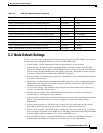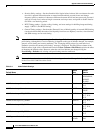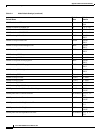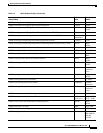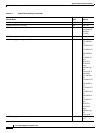
C-29
Cisco ONS 15600 Reference Manual, R7.2
Appendix C Network Element Defaults
C.3 Node Default Settings
C.3 Node Default Settings
Table C-4 on page C-30 lists the node-level default settings for the Cisco ONS 15600. Cisco provides
the following user-configurable defaults for each Cisco ONS 15600 node:
•
Circuit settings—Set the administrative state and path protection circuit defaults.
•
General settings—Set general node management defaults, including whether to use Daylight
Savings Time (DST), the IP address of the NTP/SNTP server to be used, the time zone where the
node is located, the SD path BER value, the defaults description, and whether to report loopback
conditions on Out-of-Service, Maintenance (OOS-MT) state ports.
•
Network settings—Set default gateway node type, and whether to raise an alarm when the backplane
LAN cable is disconnected.
•
OSI settings—Set Open System Interconnection (OSI) main setup, generic routing encapsulation
(GRE) tunnel, link access protocol on the D channel (LAP-D), router subnet, and TID address
resolution protocol (TARP) settings.
•
1+1 protection settings—Set whether or not protected circuits have bidirectional switching, are
revertive, and what the reversion time is.
•
BLSR protection settings—Set whether BLSR-protected circuits are revertive, and what the
reversion time is, at both the ring and span levels.
•
Legal Disclaimer—Set the legal disclaimer that warns users at the login screen about the possible
legal or contractual ramifications of accessing equipment, systems, or networks without
authorization.
•
Security Grant Permissions—Set default user security levels for activating/reverting software,
performance monitoring data clearing, database restoring, and retrieving audit logs.
•
Security Access settings—Set default security settings for LAN access, shell access, serial craft
access, element management system (EMS) access (including Internet Inter-Object Request Broker
Protocol [IIOP] listener port number), TL1 access, and SNMP access.
•
Security RADIUS settings—Set default RADIUS server settings for accounting port number,
authentication port number, and whether to enable the node as a final authenticator.
ASAP_4.pmthresholds.oc48.sts3c-9c.nearend.15min.SES 3 (seconds) 0 - 900
ASAP_4.pmthresholds.oc48.sts3c-9c.nearend.15min.UAS 10 (seconds) 0 - 900
ASAP_4.pmthresholds.oc48.sts3c-9c.nearend.1day.CV 250 (B3 count) 0 - 207360000
ASAP_4.pmthresholds.oc48.sts3c-9c.nearend.1day.ES 200 (seconds) 0 - 86400
ASAP_4.pmthresholds.oc48.sts3c-9c.nearend.1day.FC 40 (count) 0 - 6912
ASAP_4.pmthresholds.oc48.sts3c-9c.nearend.1day.NPJC-PDET 5760 (count) 0 - 691200000
ASAP_4.pmthresholds.oc48.sts3c-9c.nearend.1day.NPJC-PGEN 5760 (count) 0 - 691200000
ASAP_4.pmthresholds.oc48.sts3c-9c.nearend.1day.PPJC-PDET 5760 (count) 0 - 691200000
ASAP_4.pmthresholds.oc48.sts3c-9c.nearend.1day.PPJC-PGEN 5760 (count) 0 - 691200000
ASAP_4.pmthresholds.oc48.sts3c-9c.nearend.1day.SES 7 (seconds) 0 - 86400
ASAP_4.pmthresholds.oc48.sts3c-9c.nearend.1day.UAS 10 (seconds) 0 - 86400
Table C-3 ASAP Card Default Settings (continued)
Default Name Default Value Default Domain











